|
Duck Decoys
| By John Deeter
Posted November 2011
|
 |
While duck decoys can readily be seen in antique shops, as well as in the photos of home decorator magazines, many of the current owners probably have little appreciation or knowledge of the objects’ rich historical past. For some non-collectors, focus tends to be on the art form as an appealing piece of folk art and little more.
Decoy carving is distinctly a North American art. The earliest know examples were discovered in 1924. A rig of 2,000-year-old floating, canvasback decoys were found in a cave in Nevada’s Humboldt Range. They were obviously tools of Native American Indians.
|
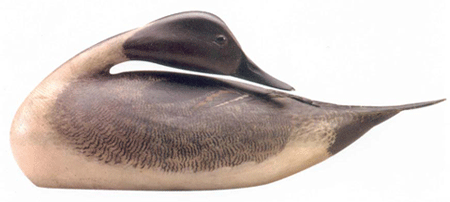
|
|
Preening Pintail: This preening pintail drake by Elmer Crowell, ca. 1915, was sold for $801,500 in Jan. 2003 by Guyette & Schmidt.
|
Decoys were first considered display-worthy as utilitarian objects in 1876 at the U.S. Centennial Fair in Philadelphia. They then achieved the status of American folk art in 1932 while on exhibit at the Museum of Modern Art where they were valued for their sculptural qualities.
Why were the decoys made? Traditional waterfowling started on the East Coast around 1850 and quickly gained steam as the thirst for fresh game in America’s growing cities blossomed. In the early days, ducks and shorebirds were plentiful, but as the demand began to increase, so did the need for market hunters and sportsman alike to own decoys. Ducks were getting smarter, and luring them with decoys was much easier than just pass shooting or trying to sneak up on them in ponds or creeks.
This period in American waterfowling, known as the “Golden Age,” was vastly unregulated. Fortunately, sportsmen began to take notice that their resource was under duress and was possibly headed to extinction. Through the efforts of organized sportsmen and politicians, the U.S. Congress ratified the Migratory Bird Treaty in 1918, which stopped market hunting and established seasons and bag limits by species.
Demand for wooden, carved and painted decoys stayed strong from about 1870 to 1950, but there were changes, due to the new regulations. The sport had moved from an unregulated environment to a very controlled and heavily-monitored one, as it is today. Many of the carvers who provided decoys for market gunners turned to the sportsman for their livelihood. Some carvers actually retired from making working decoys because they found that the demand for “decorative bird” carvings was more profitable.
The most famous carver to make this transition was Elmer Crowell of East Harwich, Mass. Elmer was a cranberry farmer who managed duck hunting clubs for wealthy sportsmen at the turn of the last century. He was most proud of his ability to train live ducks, called “tollers,” which were used to help lure wild ducks within range for his hunting guests.
After the game laws began to change, he began carving wooden decoys. Around 1905, he realized the tourists visiting the cape had a keen interest in his carvings. His repertoire consisted of miniature and full-size ducks, songbirds and shorebirds, which he stamped or branded with his name.
It wasn’t long until the demand was greater than the supply. Crowell started taking orders for his carvings, and then sometime around 1920, his son Cleon joined him in the family business. They continued carving until around 1945. The Crowell team produced thousands of duck carvings which are treasured today. Their carvings range in price from about $700 to a world-record price of $800,000 for one of his best examples.
You might wonder why one decoy could be worth almost a million dollars and why one would only be worth $700 or much less, say $50. The answer is simple: this is art. It is really no different than the great impressionist flat art that gets sold at Christie’s and Sotheby’s. The best examples made by the most desirable artists bring the most money.
The decoy world has sorted itself out in the same way. There are thousands of decoys available, but most are in poor condition, have been repaired, are not made by “important” carvers, or just don’t have a good look. There are also imposters or fakes, which is why I suggest that you start collecting decoys slowly and do your homework.
|
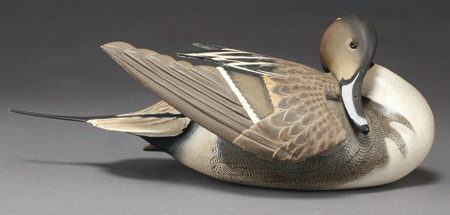
|
|
Outstanding decorative pintail drake by the Ward Brothers, Crisfield, Md. Signed on the underside: "Made Special by L.T. Ward for Betsy Lawrence, 1968". Exhibits raised wings with detailed relief carving and the head in a preening pose; $10,000–$12,000.
|
Another notable carving team was Lem and Steve Ward from Crisfield, Md. Barbers by occupation, the Wards started carving decoys around 1912. Both brothers were talented at both carving and painting, and at times, they both worked on the same decoy. They produced thousands of decoys during their working period, which lasted until the 1970s. Examples of their work can be found in popular art museums around the country, including the American Museum of Folk Art in New York City, the Shelburne Museum in Vermont, and the Abbey Aldrich Museum in Virginia.
The southeastern states of Virginia, North and South Carolina and Maryland were all heavily populated with waterfowl so they had high demand for carved wooden decoys for hunters. A number of books have been written on the duck hunting clubs of these areas as well as the individual carvers. (See the list at the end of this article.)
As you can imagine, decoy collecting can be educational, socially fun, visually rewarding and often wise for the investment portfolio, as rare art has weathered many economic storms. A few tips for the new collector are:
*First look at decoy books to see where your interests lie before taking a financial plunge. Do you want to learn more about decoys from your area, did you grow up in a popular waterfowling area and would you like to know more about it, or do you just like the look of a certain carver or species.
*Visit collections, both private and public. The Ward Museum in Salisbury, Md., is a great place to start.
*Review auction catalogs. Guyette & Schmidt sells past auction catalogs, which are great resources for looking at full-color photos of approximately 1,000 decoys and related carvings. The guaranteed descriptions and educational comments will help you learn about carvers, regions and especially about prices, as each past auction catalog comes with a price-realized insert.
Decoy collecting is a well-organized hobby with national gatherings of shows, educational seminars, auctions and buy/sell swap meets annually. Guyette & Schmidt holds three annual auctions per year. In April, we host an auction in conjunction with the National Antique Sporting Collectible Show in St. Charles, Ill.; in July, a decoy auction is held in Portsmouth, N.H.; and around the third week in July and in November, auctions are held with the Waterfowl Festival in Easton, Md. A full-color catalog with descriptions and color photos is produced for each sale.
At all of these events, decoys can be acquired for all interest levels, from the beginner looking to spend $50, up to the serious collector looking to put together an investment-grade collection. It’s quite common for antique dealers to frequent these events, as they are a great place for show inventory.
____________________________
John Deeter is co-owner of Guyette and Schmidt located in St. Michaels, Md.
To learn more about decoy collecting, obtain a free appraisal, or get more information about the events mentioned above, visit www.GuyetteandSchmidt.com
or call 440-610-1768.
Decoy-collecting books and magazines:
*Decoy Magazine
*Hunting & Fishing Collectable Magazine
*The Great Book of Wildfowl Decoys by Joe Engers
*Southern Decoys of Virginia and the Carolinas by Henry Fleckenstein
*Mattamuskeet & Ocracoke Waterfowl Heritage by Jack Dudley
*Waterfowl Heritage, North Carolina Decoys and Gunning Lore
*Gunning Birds by Krogie Andreesen
|
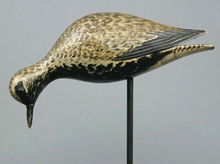
Crowell Plover: This feeding black-bellied plover in spring plumage carved the 1st quarter of the 20th c. by Elmer Crowell was sold for $830,000 in Nov. 2006 by Guyette & Schmidt.
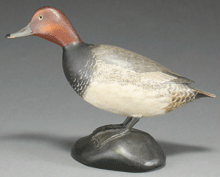
The only known full-size redhead drake by Elmer Crowell, East Harwich, Mass. Very full body with fine feather paint detail and fluted tail, good patina, near mint original paint, very slight paint shrinkage on upper breast; several tiny paint rubs missing. His oval brand is on the underside; $140,000–$160,000.
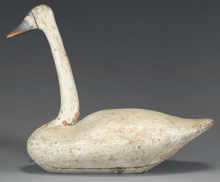
Very rare swan by John Williams of Cedar Island, Va., last quarter of 19th c. Excellent dry old surface with moderate flaking to more than one coat of paint; crack runs down the bottom and partway up the breast; roughly 2/3 of the bill has been professionally replaced; at some point the lead ballast weights have been removed; $140,000–$160,000.
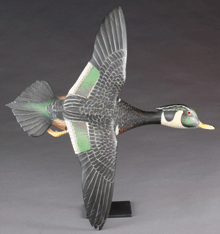
Rare flying wood duck drake by Elmer Crowell, 1st quarter of 20th c. The back side has been flattened to accommodate hanging on the wall. The wing span is 19 1/2", the length from bill to tail is 18". Written of the back side of one wing in Crowell's hand script is "Woodduck male A.E. Crowell Maker Cape Cod"; $9,500 – $12,500.
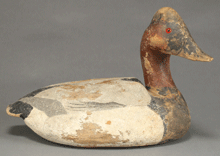
Canvasback : Early canvasback, so-called “knot-head” model by Ward Brothers, Crisfield, Md., ca. 1928.
|